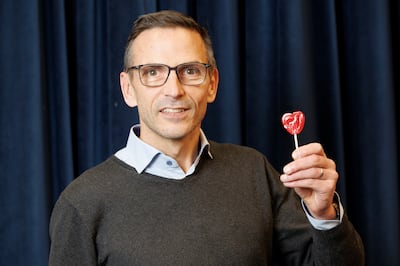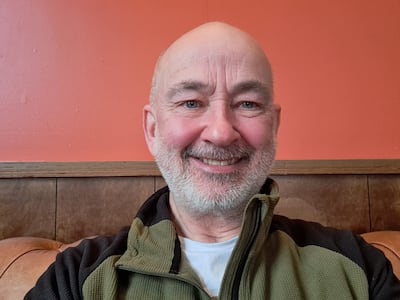When IT support consultant Justin Farrell heard his surgeon explain what an upcoming cancer operation would entail, he had visions of the closing scenes of Braveheart, where the Mel Gibson character, Scottish rebel William Wallace, is hanged, drawn and quartered.
A touch of catastrophising perhaps – but there is no denying that the removal of part, or all, of the oesophagus (food pipe), which transports food and liquid from the throat to the stomach, is major surgery. In a procedure known as an oesophagectomy, the stomach is pulled up into the chest and used to create a new tubular connection over the gap.
The really hard thing about listening to what they were going to do to his body, says Farrell, was that he had no symptoms of the oesophageal cancer he had been diagnosed with. In his head, “I was fine, there was nothing wrong with me.” Indeed, up to a few months previously, he had been among the one in three men in Ireland who, according to recent research, are unaware of this type of cancer.
What’s more, as a fit 51-year-old who went to the gym, swam in the sea all year round in his home town of Greystones, Co Wicklow, and generally looked after himself, he thought cancer was something that happened to other people.
In hindsight, he knows how stupid that was.
For about 10 years, Farrell had the minor discomfort of heartburn, but was unaware that this very common ailment can be a forerunner to developing oesophageal cancer. The regular flushing up of stomach acid may cause cellular changes in the lining of the food pipe – a condition known as Barrett’s oesophagus. In a very small number of cases, this will develop into cancer, but patients need to be monitored. “I’d be the one that would have antacid tablets in my car, in my coat, in my gym bag, in the laptop.”
On the advice of his mother, he had the heartburn checked out. An endoscopy found redness on the lining of his food pipe, but it was not yet classed as Barrett’s.
Farrell did go back for a scope every two to three years, but then “with Covid, basically I forgot all about it”. In April 2023, “out of the blue”, he says, his mother reminded him he had not had a scope for a long time. “For some reason I listened – normally I don’t listen to her at all,” he jokes.
He is glad he did. Barrett’s was identified this time and he was referred to upper GI surgeon William Robb in Beaumont Hospital, Dublin, for further investigation and biopsies in September of that year. Although Farrell sensed it could not mean good news to be called back to the hospital a few days later, he was still not expecting to hear he had early stage cancer.

However, his condition appeared to be superficial, and it was hoped a minimally invasive procedure, called an endoscopic submucosal dissection (ESD), might be enough to scrape away the cancerous cells from the lining. The ESD one month later did clear most of the cells, but “there was a tiny percentage that was a little bit deeper”. Farrell was told that if he was in his 70s they would just keep an eye on it, but because he was only 51, they would, on balance, recommend the major surgery.
After a couple of weeks’ mulling, Farrell settled on the thought, “basically I have cancer cells in me, I would be really crazy not to go ahead with it”.
While he was shocked to hear what the procedure involved, he was then “blown away” to be told he could expect to be out of hospital within a week, because it would be done by robotic surgery. This most modern method of surgery allows patients to recover rapidly and more easily from these big traumatic operations, Robb tells The Irish Times. “It’s not a robot doing the operation – that can be a misunderstanding by the public and by patients,” he says. Rather, it is technology applied to keyhole surgery, which itself is a technological progression from open surgery.
Traditionally for an oesophagectomy, the patient has to have a very large incision in their abdomen to prepare the stomach tube, he says. “Then an incision between the ribs where the surgeon would put their hands inside the patient and operate manually at the bedside.” The recovery time in hospital would be at least two or three weeks.
‘We’re not standing at the bedside holding instruments, which is a much more fatiguing aspect to an operation that can last from 9 o’clock in the morning until 4 or 5 in the afternoon’
— Upper GI surgeon William Robb
Then the operation started being done through minimally invasive, or keyhole, surgery. “The surgeon would stand at the patient’s bed at the bedside, hold the instruments in his hands and operate with rigid stick inflexible instruments.”
Now, a robotic platform has been developed to hold the miniaturised instruments (inserted through tiny skin incisions) within the patient, while the surgeon sits at the side of the room to manipulate these instruments from a console.
“We have our head in a vision cart and, in front of us, we get a very magnified, three-dimensional vision of what’s going on internally in the patient. Then, using hand controls, we can control the tips of the instruments within the patient.”
These instruments are extremely dexterous and can move in all directions, “like little hands within the patients”, facilitating a more radical and very precise cancer operation.
Robb has led the development of this type of robotic surgery at Beaumont since just before the pandemic. Initially, he used it for benign conditions to build up his skills before transferring it to his cancer surgery. He and his team have done more than 100 cases robotically now, “that’s mainly oesophageal cancer, some stomach cancer as well”.
What does this changed way of working mean for the surgeon?
“In traditional keyhole surgery we stand by the patient holding instruments; we have tactile feedback, we can feel how hard we’re pulling on things. In robotic surgery, you don’t have any of that tactility, so you really have to develop a lot of visual clues to train your brain into knowing how hard you’re pulling or retracting on anything.
“It’s certainly a more relaxed way of operating,” he continues, and that keeps surgeons fresher through lengthy surgery. “We’re not standing at the bedside holding instruments, which is a much more fatiguing aspect to an operation that can last from 9 o’clock in the morning until 4 or 5 in the afternoon.”
While it probably also means fewer back and postural problems for surgeons in the long run, these considerations are “very much secondary to the benefits that this provides patients”.
Integration of AI into this robotic technology will, he says, bring further advances, potentially helping to prevent surgeons or instruments causing any injuries internally. Just as car safety features include warning bleeps for parking and lane changing, these instruments could, he adds, “cut out and say, ‘No, I recognise that’s the aorta, you can’t stick your instrument in there’.”
The Oesophageal Cancer Fund (ocf.ie) wants to stop people reaching the point of needing surgery. More than 500 people are diagnosed with this type of cancer each year in Ireland and about 70 per cent of them will have had possible symptoms for three months or more before contacting their doctor. The OCF’s annual fundraising “Lollipop Day” campaign, on February 28th and March 1st this year, aims also to raise awareness of red flags, such as heartburn and reflux, and what Robb describes as a “sinister” symptom, difficulty swallowing.
Farrell is very grateful that he was able to benefit from Robb’s expertise in advanced technology for his operation in January 2024, which lasted about eight hours. “Instead of cutting me open, there’s about 12 little keyhole entries around the body and maybe half an inch on my side where they had to use a clamp, and that’s where they took out the oesophagus.”
A feeding tube direct into his stomach was removed after two weeks and he did not need any follow-up chemotherapy or radiation. Although he was warned to forget the lifestyle of three meals a day, the impact on his eating has been less than he feared. However, curiously, he has been left with a dislike of tea, having once been a “14 cups a day” man.
But, overall, one year on from the surgery, Farrell says, “I’m pretty much back to what I could do before, which is incredible.”
A very challenging operation
When Andrew Kelly developed persistent heartburn, he put it down to diet and a stressful job. “I stocked up with Gaviscon and got on with things.”
But it was his wife who persuaded him to go to the GP, and that led on to a diagnosis of Barrett’s oesophagus in 2018 at age 55 – but there was no sign of cancer. He was due a repeat endoscopy two years later, but that was cancelled due to Covid. For various reasons it ended up being May 2023 before he had another one.
‘I think it was difficult when I came out of hospital, not knowing whether the operation had been a success in terms of clearing my body from the cancer’
— Andrew Kelly
“This time they took biopsies and found some malignant cells. It was still caught at a very early stage, even though it was almost five years between the two endoscopies. It just reinforces the need for monitoring and early diagnosis and early intervention.”
He had overlapping courses of chemotherapy and radiation in the autumn of 2023 before undergoing open surgery in Beaumont that November to remove about two-thirds of his oesophagus. It was a very challenging operation, lasting almost 12 hours, and he was in hospital for two weeks afterwards.
He does not feel hard done by, however, that he was not able to have keyhole or robotic surgery. “I was given the surgery that was available at the time in the hospital.”

Psychologically it had an impact too, even though the cancer
was caught early. The five-year survival rate for oesophageal cancer is only 25 per cent in the Republic (and even lower in the North at 19 per cent), due to relatively late diagnoses in many cases.
“I think it was difficult when I came out of hospital, not knowing whether the operation had been a success in terms of clearing my body from the cancer.” He also strongly disliked having a feeding tube going into his stomach for six weeks afterwards. Follow-up immunotherapy had to be cut short due to the side-effects he experienced.
He found great support through services at the Gary Kelly cancer centre in Drogheda, a place he had driven past countless times to and from his Co Louth home, never dreaming he would be knocking on its door one day. As only 25 per cent of its clients are men, he would encourage more male cancer survivors to avail of such supports.
“I still have periods where I get very fatigued,” adds Kelly, who is back working for a UK charity. “I’ve had two CT scans since my surgery and the good news is that there’s no signs of cancer so, from that perspective obviously, the treatment and everything has been very successful.”






















